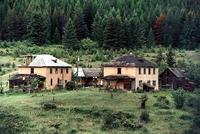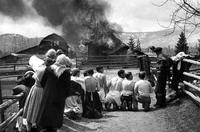Doukhobors
DOUKHOBORS
()
are a religious sect of Russian Christians dating back to the 18th century. The term means "spirit wrestlers" or heretics and was adopted by the sect as a proud emblem of their spiritual struggle. Persecuted at home for their pacifism and unorthodox theology, about 7,500 Doukhobors came to Canada in 1899 in search of religious freedom. The government granted them land in present-day Saskatchewan and Manitoba, exempted them from military service and tolerated the development of their own distinctive settlement patterns. Within a few years, however, the government took steps to regain some of the land it had granted and required the Doukhobors to swear allegiance to the British Crown and to break up their communal holdings into individual properties. Objecting to the new conditions, about 5,000 Doukhobors led by Peter ("Peter the Lordly") VERIGIN migrated west beginning in 1908 to the KOOTENAY and the BOUNDARY DISTRICT of southeastern BC; there they formed settlements at BRILLIANT, Pass Creek, Glade, SHOREACRES, Ootischenie, Champion Creek and GRAND FORKS. They continued to follow a communal lifestyle, living an austere, isolated life engaged in community enterprises. In 1917 the Doukhobors incorporated as the Christian Community of Universal Brotherhood Ltd (CCUB), later the Union of Spiritual Communities of Christ. When Verigin died in a train explosion in 1924 he was succeeded as leader by his son, Peter Petrovich Verigin (1880–1939). During the Depression the CCUB lost its lands to creditors and the communal system disintegrated, but in the 1950s the provincial government sold properties back to individual Doukhobors. The outside world looked upon the Doukhobors with suspicion, in part because of their pacifism and their resistance to government registration. As animosity developed, public schools became the focus of Doukhobor resistance to government authority and some members of the community withheld their children. In 1923 the first schools were burned as a protest and clashes within the community and between the community and the authorities continued for the next 40 years. Doukhobors were denied the federal and provincial vote from 1931 to 1956 because they were conscientious objectors, and during the 1950s about 170 Doukhobor children were removed from their families and sent to a government boarding school. On the prairies the sect had developed 2 dissident elements: Independents, who favoured varying degrees of accommodation with mainstream society, and Sons of Freedom, a radical fundamentalist element that sometimes employed the nude march as a form of protest against western secularism. From the 1920s the Sons of Freedom carried on what amounted to a guerrilla war against assimilation into Canadian society, especially in BC. It is this minority that was responsible for most of the incidents of arson, bombing and public nudity that lasted to the 1960s, peaking with the Great Trek of protestors to VANCOUVER in 1963. The protest finally exhausted itself, as did overt attempts to force the Doukhobors to assimilate. Today about 15,000 Doukhobors live in BC, mainly at CASTLEGAR, Grand Forks and in Vancouver. See also PIERS ISLAND.
Reading: George Woodcock and Ivan Avakumovic, The Doukhobors, 1968.


